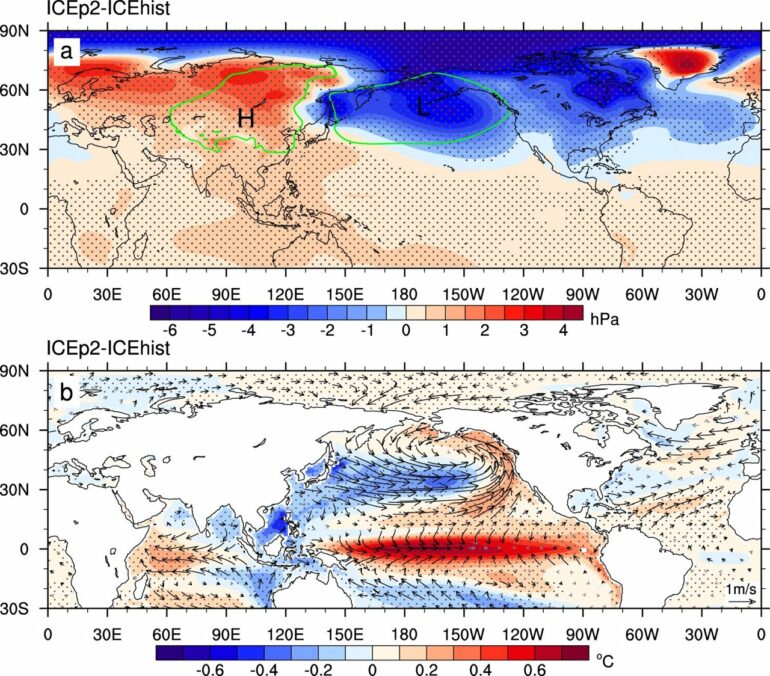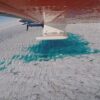Over the last 40 years, a rapid shrinking of Arctic sea ice has been one of the most significant indicators of climate change. The amount of sea ice that survives the Arctic summer has declined 13% per decade since the late 1970s and projections show the region could experience its first ice-free summer by 2040.
This rapid melting is not just disruptive to surrounding coastal cities and small island nations; it also may have a lasting impact on global weather patterns, according to new paper from a University at Albany researcher.
In a new Nature Communications paper, researchers have revealed that the magnitude and pattern of Arctic sea-ice loss can directly influence El Niño. Further, as the Arctic becomes seasonally ice-free, the frequency of strong El Niño events increases significantly.
El Niño is a complex weather pattern that occurs when surface water in the central and eastern Pacific Ocean becomes warmer than average and east winds blow weaker than normal. The events, which typically occur every few years, can produce unusual and, sometimes dangerous, weather conditions around the world including droughts, floods and severe storms.
Prior to this study, little was known about whether dwindling Arctic sea ice is capable of influencing strong El Niño events, according to its lead author Jiping Liu, an associate professor in UAlbany’s Department of Atmospheric and Environmental Sciences in the College of Arts and Sciences.
“El Niño is an important climate phenomenon, recognized as a driver of climate variability responsible for large and diverse societal impacts,” Liu said. “Our study, for the first time, finds that large Arctic sea-ice loss directly influences global climate extremes, including an increase in the frequency of strong El Niño events.”
Modeling sea ice
Liu and colleagues ran a series of time slice model simulations that relied on atmosphere, land, ocean and sea ice variables to determine the influence of Arctic sea ice loss on El Niño events.
Before running the simulations, they directly fixed Arctic sea ice cover during three time periods—1980–99, 2020–2039 and 2080–99. The simulations were generated using the National Center for Atmospheric Research’s Community Climate System Model, a global climate model that provides state-of-the-art computer simulations of the Earth’s past, present and future climate states.
By comparing the simulations, the researchers found no significant change in the occurrence of strong El Niño events in response to moderate Arctic sea-ice loss, which is consistent with satellite observations to date. However, as the ice loss continues and the Arctic becomes seasonally ice-free, the frequency of strong El Niño events increases by more than one-third.
“After decades of research, there is general, albeit not universal, agreement that the frequency of El Niño events, especially extremely strong El Niño events, will increase under greenhouse warming,” Liu said. “Since Arctic sea ice is projected to continue to decline dramatically, it was important to assess whether the projected increase in strong El Niño can be directly connected.”
To separate the role of Arctic sea ice loss and greenhouse gas emissions, the researchers conducted an additional experiment in which Arctic sea ice cover was fixed based on the historical simulations, but increased carbon dioxide levels by 1% for 100 years starting from its level in the year 2000. They conclude that at least 37–48% of the increase of strong El Niño events near the end of the 21st century would be associated specifically with Arctic sea ice loss.
“It is becoming clearer that climate models need to simulate decreasing Arctic sea ice realistically in order to correctly simulate El Niño variability,” Liu said.
Climate change in the arctic
Liu’s latest research adds to his substantial contributions to understanding sea ice variability and its role in global climate dynamics.
In 2016, he published a study in the Journal of Climate that showed how Arctic sea ice melt is an underlying cause of the shrinking of the Greenland ice sheet observed in recent decades. He was also the lead author of a 2019 study that aimed to improve Arctic sea ice prediction, at daily to seasonal time scales, using multivariate data assimilation.
Along with Liu, collaborators on the new study include Mirong Song and Zhu Zhu of the Chinese Academy of Sciences, Radley Horton of Columbia University, Yongyun Hu of Peking University and Shang-Ping Xie of the University of California San Diego.
More information:
Jiping Liu et al, Arctic sea-ice loss is projected to lead to more frequent strong El Niño events, Nature Communications (2022). DOI: 10.1038/s41467-022-32705-2
Provided by
University at Albany
Citation:
Arctic sea ice loss leads to more frequent strong El Niño events (2022, September 23)



